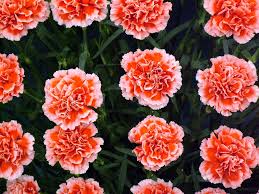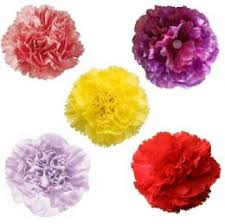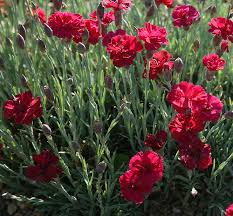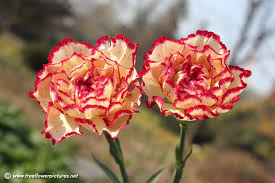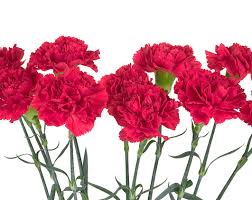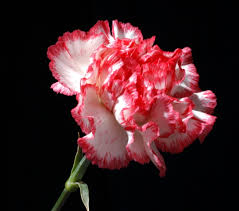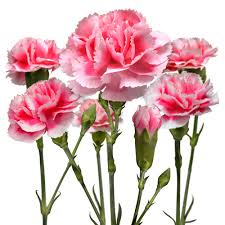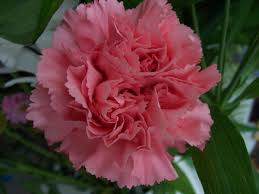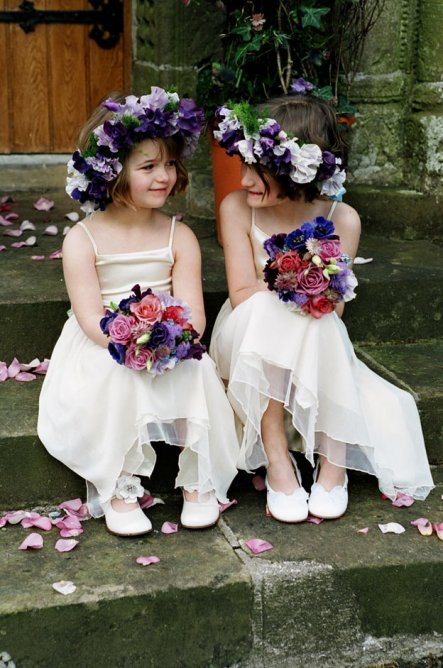A Fairy's house stands in a wood,
Midst fairy trees and flowers,
Where daisies sing like little birds
Between the sun and showers,
And grasses whisper tiny things
About this world of ours. --
Such flowers are there beside the way,
Lilies and hollyhocks:
Blow off their stalks to tell the time
Tall dandelion clocks;
While pansies ring an hourly chime
Like a wound music-box. --
Some day shall we two try to find
This strange enchanted place?
Go hand in hand through flower-lit woods
Where living trees embrace--
And suddenly, as in a dream,
Behold a fairy's face!
(¯`?´¯) .?´ peace

Freesia
Freesia is a genus of around 16 species of flowering plants in the family Iridaceae, native to the eastern side of southern Africa, from Kenya down to South Africa, most species being found in Cape Province.[citation needed] Species of the former genus Anomatheca are now included in Freesia. The plants commonly known as "freesias", with fragrant funnel-shaped flowers, are cultivated hybrids of a number of Freesia species. Some other species are also grown as ornamental plants.
They are herbaceous plants which grow from a corm 1–2.5 cm diameter, which sends up a tuft of narrow leaves 10–30 cm long, and a sparsely branched stem 10–40 cm tall bearing a few leaves and a loose one-sided spike of flowers with six tepals. Many species have fragrant narrowly funnel-shaped flowers, although those formerly placed in the genus Anomatheca, such as F. laxa, have flat flowers.
Freesias are used as food plants by the larvae of some Lepidoptera species including Large Yellow Underwing.
The World Checklist of Selected Plant Families lists 16 species as of August 2012.
Freesia alba (G.L.Mey.) Gumbl. (syn. F. gentilis N.E.Br., F. herbertii N.E.Br., F. picta N.E.Br.)
Freesia andersoniae L.Bolus
Freesia caryophyllacea (Burm.f.) N.E.Br. (syn. F. elimensis L.Bolus, F. parva N.E.Br., F. xanthospila (DC.) Klatt)
Freesia corymbosa (Burm.f.) N.E.Br. (syn. F. armstrongii W.Watson, F. brevis N.E.Br.)
Freesia fergusoniae L.Bolus
Freesia fucata J.C.Manning & Goldblatt
Freesia grandiflora (Baker) Klatt
Freesia laxa (Thunb.) Goldblatt & J.C.Manning (syn. F. cruenta (Lindl.) Klatt)
Freesia leichtlinii Klatt (syn. F. middlemostii F.Barker, F. muirii N.E.Br.)
Freesia marginata J.C.Manning & Goldblatt
Freesia occidentalis L.Bolus (syn. F. framesii L.Bolus)
Freesia refracta (Jacq.) Klatt (syn. F. hurlingii L.Bolus)
Freesia sparrmanii (Thunb.) N.E.Br.
Freesia speciosa L.Bolus (syn. F. flava (E.Phillips & N.E.Br.) N.E.Br.)
Freesia verrucosa (B.Vogel) Goldblatt & J.C.Manning (syn. F. juncea (Pourr.) Klatt)
Freesia viridis (Aiton) Goldblatt & J.C.Manning
Species of the former genus Anomatheca are now included in Freesia:
Anomatheca cruenta Lindl. = Freesia laxa subsp. laxa
Anomatheca grandiflora Baker = Freesia grandiflora
Anomatheca juncea (Pourr.) Ker Gawl. = Freesia verrucosa
Anomatheca laxa (Thunb.) Goldblatt = Freesia laxa
Anomatheca verrucosa (B.Vogel) Goldblatt = Freesia verrucosa
Anomatheca viridis (Aiton) Goldblatt = Freesia viridis
Anomatheca xanthospila (DC.) Ker Gawl. = Freesia caryophyllacea





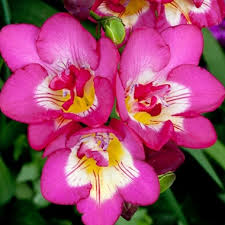
Cultivation and uses
The plants usually called "freesias" are derived from crosses made in the 19th century between F. refracta and F. leichtlinii. Numerous cultivars have been bred from these species and the pink- and yellow-flowered forms of F. corymbosa. Modern tetraploid cultivars have flowers ranging from white to yellow, pink, red and blue-mauve. They are widely cultivated and readily increased from seed. Due to their specific and pleasing scent, they are often used in hand creams, shampoos, candles, etc.[citation needed]
They can be planted in the fall in USDA Hardiness Zones 9-10 (i.e. where the temperature does not fall below about −7 °C (20 °F)), and in the spring in Zones 4-8.
F. laxa (formerly called Lapeirousia laxa or Anomatheca cruenta) is one of the other species of the genus which is commonly cultivated. Smaller than the scented freesia cultivars, it has flat rather than cup-shaped flowers.
Extensive 'forcing' of this bulb occurs in Half Moon Bay California where several growers chill the bulbs in proprietary methods to satisfy cold dormancy which results in formation of buds within a predicted number of weeks – often 5 weeks at 55°F.
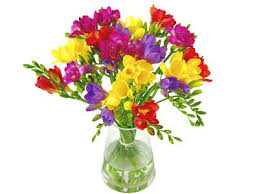


Kingdom: Plantae
(unranked): Angiosperms
(unranked): Monocots
Order: Asparagales
Family: Iridaceae
Subfamily: Ixioideae
Genus: Freesia




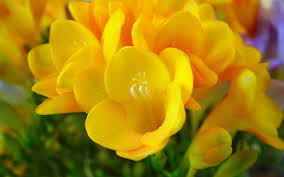

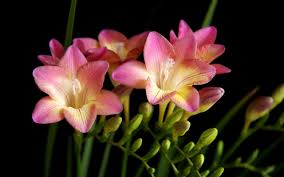

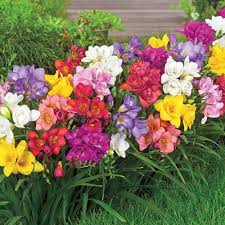


carnation flowers



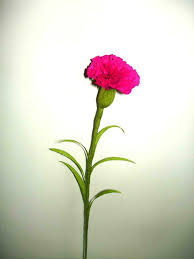
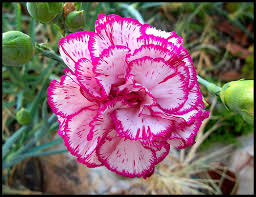
 Dianthus caryophyllus, carnation or clove pink, is a species of Dianthus. It is probably native to the Mediterranean region but its exact range is unknown due to extensive cultivation for the last 2,000 years.
Dianthus caryophyllus, carnation or clove pink, is a species of Dianthus. It is probably native to the Mediterranean region but its exact range is unknown due to extensive cultivation for the last 2,000 years.
It is a herbaceous perennial plant growing to 80 cm tall. The leaves are glaucous greyish green to blue-green, slender, up to 15 cm long. The flowers are produced singly or up to five together in a cyme; they are 3–5 cm diameter, and sweetly scented; the original natural flower colour is bright pinkish-purple, but cultivars of other colours, including red, white, yellow and green, have been developed.
Kingdom: Plantae
(unranked): Angiosperms
(unranked): Eudicots
(unranked): Core eudicots
Order: Caryophyllales
Family: Caryophyllaceae
Genus: Dianthus
Species: D. caryophyllus
Growing carnations
Carnations require well-drained, neutral to slightly alkaline soil, and full sun. Numerous cultivars have been selected for garden planting. Typical examples include 'Gina Porto', 'Helen', 'Laced Romeo', and 'Red Rocket'.
Colombia is the largest carnation producer in the world.
Colors
Carnations do not naturally produce the pigment delphinidin, thus a blue carnation cannot occur by natural selection or be created by traditional plant breeding. It shares this characteristic with other widely sold flowers like roses, lilies, tulips, chrysanthemums and gerberas.
Around 1996 a company, Florigene, used genetic engineering to extract certain genes from petunia and snapdragon flowers to produce a blue-mauve carnation, which was commercialized as Moondust. In 1998 a violet carnation called Moonshadow was commercialized. As of 2004 three additional blue-violet/purple varieties have been commercialized.
Carnations were mentioned in Greek literature 2,000 years ago. "Dianthus" was coined by Greek botanist Theophrastus, and is derived from the Greek words for divine ("dios") and flower ("anthos"). Some scholars believe that the name "carnation" comes from "coronation" or "corone" (flower garlands), as it was one of the flowers used in Greek ceremonial crowns. Others think the name stems from the Latin "caro" (genitive "carnis") (flesh), which refers to the original colour of the flower, or incarnatio (incarnation), which refers to the incarnation of God made flesh.
Although originally applied to the species Dianthus caryophyllus, the name Carnation is also often applied to some of the other species of Dianthus, and more particularly to garden hybrids between D. caryophyllus and other species in the genus.
